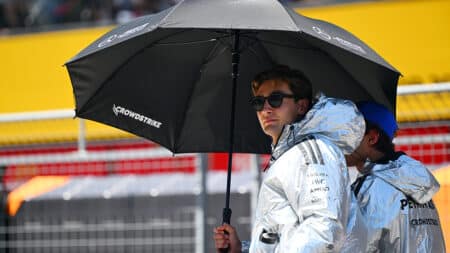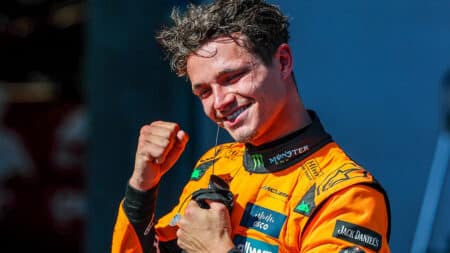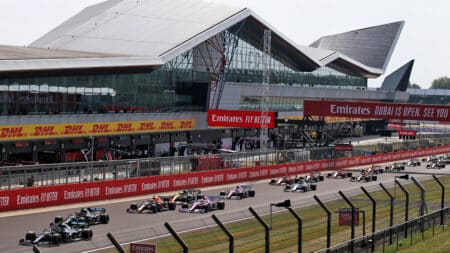
2025 is F1’s most polite title battle ever – Up/Down in Austria
Describing this year's championship race as a 'battle' might be slightly over-egging it, writes James Elson
A series taken from the 164-page Motor Sport special Great Racing Cars, which is available to buy here.
Click here to buy the above image
From the editor Damien Smith
How would you define a ‘great’ racing car? Race wins and championship titles are an obvious place to start – and admittedly, when we began the process of rounding up the ‘voices’ to fill this special magazine, published by the team behind Motor Sport, we had in mind the likes of the Lotus 72, Ferrari F2004, Porsche 917, Audi R10 and so on.
But as the interviews of familiar racing figures began, we realised greatness is often a very personal thing. Naturally, most – but not all – would pick cars they had experienced first-hand, as a driver, designer, engineer or team boss. And on occasion the cars that stood out in their minds as ‘great’ weren’t necessarily so in the grand scheme of history. That’s why you’ll find a Minardi here among Formula 1 cars from Lotus, Williams and McLaren.
Unexpected? Certainly. Wrong? Not to the man who chose it.
As the interviews accumulated, our magazine took on a life of its own, full of personal anecdotes about the myriad cars that made careers. Some of those we spoke to, such as Mario Andretti and Dan Gurney, couldn’t be tied to a single choice from multi-faceted lives at the wheel. Such heroes have earned the right to choose an F1, sports and Indycar, so we allowed them more than one bite.
Others refused to be confined by category. Hence the short ‘Odd ’n Sods’ chapter on cars that, by and large, are mere footnotes in lower divisions of racing lore.
Thus there is nothing definitive about the selection listed herein. Then again, there’s no claim that this compilation offers the ‘Greatest Racing Cars’ of history. It’s much more personal than that, much more quirky – and all the better for it.
Bruno Giacomelli
F2 and F3 champion, GP veteran
My favourite car of all time is the Lotus 72, Jochen Rindt’s car. I loved it so much. From the engineering and design point of view it was just amazing.
Notable entrants: Team Lotus, Rob Walker
Notable drivers: Jochen Rindt, Emerson Fittipaldi, Ronnie Peterson, Jacky Ickx, Reine Wisell, John Miles, Graham Hill
Debut: 1970 Spanish Grand Prix
Achievements: 20 wins, 17 poles
Constructors’ Championships: 3 (1970, 1972, 1973)
Drivers’ Championships: 2 (1970, 1972)
I know that Maurice Philippe had a lot to do with the design of the car and that he worked on it with Colin Chapman. I got to know Maurice a little bit when he worked at March and we spent some time on the March IndyCar, which they supplied for the Alfa project with which I was involved. It was a pleasure for me to talk and work with him just for a few days in 1989 at Fiorano, where we tested. I was a secret fan of his work!
The Lotus 72, just like the McLaren M23, lasted for so long in different evolutions. I think that shows how good the car was, because it had a long and successful life. It had great aerodynamics and with inside (inboard) brakes it made the car look so clean. It also had the torsion bar and anti-dive suspension set-up, which initially had problems but was soon shown to be the future in F1.
It was a design that was way ahead of any other cars on the grid at the time, so it was ‘the future’ – typical of Lotus and a big vision from Chapman and Philippe.
At Monza in 1970 I was just 18 years old and only a fan. I got to the track just after Jochen’s accident and couldn’t understand what had happened. I remember it very clearly and was so sad. The next day Regazzoni won for Ferrari and it was like nothing had happened, very strange. The tifosi went crazy but I was still so sad for Jochen and that the Lotus 72 would not be in action that day. Lotus had gone home and that day I must have been the only Italian who was not interested so much in Regazzoni and Ickx.
I wish I’d designed…
Adrian Newey on the car that inspired him as a child
For me it’s the Lotus 72, an emotional choice as much as a design one. It came out in 1970 when I was 11 and getting interested in motor sport, starting to appreciate the designs. I began to build Tamiya kits. These were very accurate, very good for teaching you the names of the components and how they fitted together. They helped me appreciate the design much more than spectating did. The 72 was a pretty big lateral departure from its competitors; the cars at that time were still very much the classic 1960s cigar shape, but with wings bolted on as an afterthought. Chapman decided to go the wedge-shaped route, which was relatively novel, designing the car around the aerodynamics rather than vice versa. There was no airflow management underneath the 72, it was a first step. But it was saying, ‘Let’s think about the aerodynamics from the root of the design.’
It was one of the first to have its radiators ahead of the rear wheels; that follows on from the wedge shape, which dictates very little space in the nose.
I imagine that was partly for penetration, letting the front wings work as well as possible, and partly because it’s a good packaging solution, with short pipe runs and keeping the weight of the radiators central, reducing the polar moment. An elegant solution, mechanically and aerodynamically.
It had torsion-bar suspension, not the first car to use it in F1, but it reintroduced the concept presumably for reduced weight and better packaging than a coil spring.
But you’re creating an extra problem because you can’t buy ready-made torsion bars like you can springs, it’s a question of how you push design against production. Modern F1 cars, without exception, have torsion-bar front suspension, and most have it at the rear, too. It’s a trend that has been followed several years later, though not necessarily for the same reasons. Lotus did a neat job of installing inboard front brakes while tweaking the wedge shape, with those little conning towers to extract the air.
Today, carbon discs and light calipers form a relatively small percentage of the unsprung weight, but they were using iron discs and heavy calipers, so, especially with the small front wheels of the time, the brakes were a big fraction of the unsprung weight, hence moving them inboard.
I’d not seen a Lotus 72 since I was a teenager, and when I saw one a couple of years ago I was surprised at how big it was. I had the impression at the time that it was rather small, but now the monocoque seems broad. Cars have got much slimmer now, a reflection of progress and not a criticism of the 72.
In the early years Chapman was very much the designer and engineer, but Maurice Philippe was heavily involved from the Lotus 49 onwards, so it’s less clear who was responsible for what. It’s probably true that, latterly, Chapman was getting more credit than he was due, when it was people working for him who were coming up with the ideas. But nevertheless there’s no doubt he was a highly talented and ingenious designer. The 72 prompted people to think about how to integrate the aerodynamics into the design, with broader wings a better overall package. Whether they copied it, or it simply triggered fresh ideas, it pushed thinking into new areas.
I believe it was quite common in those days for people to produce a new car that wasn’t as good as they’d hoped, and not to understand why. You might take two steps forwards and one back and still be pleased with yourself because you had made some progress.
In a way it would be exciting because you would have to use your intuition, yet if you’d made a mistake and couldn’t understand why, it must have been very frustrating.
Taken from the August 2000 issue of Motor Sport. To read more, click here.

Describing this year's championship race as a 'battle' might be slightly over-egging it, writes James Elson

You had to read between the lines at the 2025 Austrian Grand Prix as George Russell dropped hints over about his dissatisfaction, and F1 sent a message to FIA president Mohammed Ben Sulayem

From zero to hero: in a pacy McLaren, at one of his favourite F1 circuits, Lando Norris picked himself up from a disastrous Canadian race to reign supreme in the 2025 Austrian Grand Prix

Full F1 schedule for the year, including the next F1 race of 2025: the British Grand Prix at Silverstone, the whole calendar and circuit guides for the 24-race Formula 1 season